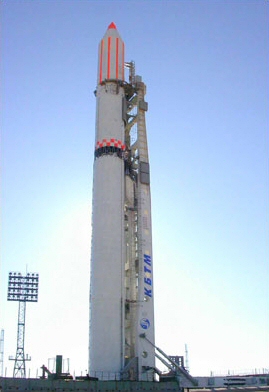Zenit rocket

Zenit-2 rocket (Baikonur, 10 December 2001)
|
|
| Function | Medium-lift expendable carrier rocket |
|---|---|
| Manufacturer | |
| Country of origin | |
| Size | |
| Height | 57–59.6 m (187–196 ft) |
| Diameter | 3.9 m (13 ft) |
| Mass | 444,900–462,200 kg (980,800–1,019,000 lb) |
| Stages | 2 or 3 |
| Capacity | |
| Payload to LEO | Zenit-2: 13,740 kg (30,290 lb) |
| Payload to SSO | Zenit-2: 11,380 kg (25,090 lb) |
| Payload to GTO | Zenit-3SL: 6,000 kg (13,000 lb) |
| Launch history | |
| Status | Active |
| Launch sites | |
| Total launches |
|
| Successes |
|
| Failures |
|
| Partial failures |
|
| First flight |
|
| Last flight |
|
| First stage | |
| Engines | 1 RD-171 |
| Thrust | 8,180 kilonewtons (1,840,000 lbf) |
| Specific impulse | 337 seconds (3.30 km/s) |
| Burn time | 150 seconds |
| Fuel | RP-1/LOX |
| Second stage | |
| Engines | 1 RD-120 1 RD-8 |
| Thrust | 912 kilonewtons (205,000 lbf) 79,500 newtons (17,900 lbf) |
| Specific impulse | 349 seconds (3.42 km/s) |
| Burn time | 315 seconds |
| Fuel | RP-1/LOX |
| Third stage (Zenit-3SL/3SLB) - Block DM-SL | |
| Engines | 1 RD-58M |
| Thrust | 84,900 newtons (19,100 lbf) |
| Specific impulse | 352 seconds (3.45 km/s) |
| Burn time | 650 seconds |
| Fuel | RP-1/LOX |
| Third stage (Zenit-3F) - Fregat-SB | |
| Engines | 1 S5.92 |
| Thrust | 19,600 newtons (4,400 lbf) |
| Specific impulse | 327 seconds (3.21 km/s) |
| Burn time | 877 seconds |
| Fuel | N2O4/UDMH |
Zenit (Ukrainian: Зеніт, Russian: Зени́т; meaning Zenith) is a family of space launch vehicles designed by the Yuzhnoye Design Bureau of Soviet Union, and since the early 1990s by the same design bureau but now a part of Ukraine. Zenit was built in the 1980s for two purposes: as a liquid rocket booster for the Energia rocket and, equipped with a second stage, as a stand-alone up-middle launcher greater than 7-ton payload Soyuz and smaller than 20-ton payload Proton. The last rocket family developed by the USSR, the Zenit was intended as an eventual replacement for the dated R-7 and Proton families, moreover it would employ propellants which were safer and less toxic than the Proton's nitrogen tetroxide/UDMH mix. Moreover, Zenit was planned to take over manned spaceship launches from Soyuz, but these plans were abandoned after the dissolution of the Soviet Union in the early 1990s.
Zenit-3SL is launched by the Sea Launch consortium's floating launch platform in the Pacific Ocean and Zenit-2 is launched from Baikonur Cosmodrome in Kazakhstan. The engines of the Zenit's first and second stages as well as the upper stage of the Zenit-3SL rocket are supplied by Russia. There are plans to use an improved Zenit-3SLB rocket for commercial launches from Baikonur Cosmodrome beginning in April 2008. This service is marketed as "Land Launch."
Zenit-3SL has launched 36 times with 32 successes, one partial success, and three failures. The first failure, the launch of a Hughes-built communications satellite owned by ICO Global Communications, occurred during the second commercial launch on March 12, 2000 and was blamed on a software error that failed to close a valve in the second stage of the rocket. The second failure occurred on January 30, 2007 when the rocket exploded on the Odyssey launch platform, seconds after engine ignition. The NSS-8 communication satellite on board was destroyed.
...
Wikipedia
